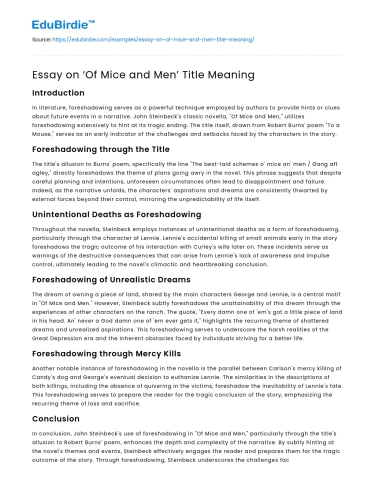Introduction
In literature, foreshadowing serves as a powerful technique employed by authors to provide hints or clues about future events in a narrative. John Steinbeck's classic novella, "Of Mice and Men," utilizes foreshadowing extensively to hint at its tragic ending. The title itself, drawn from Robert Burns' poem "To a Mouse," serves as an early indicator of the challenges and setbacks faced by the characters in the story.
Foreshadowing through the Title
The title's allusion to Burns' poem, specifically the line "The best-laid schemes o' mice an' men / Gang aft agley," directly foreshadows the theme of plans going awry in the novel. This phrase suggests that despite careful planning and intentions, unforeseen circumstances often lead to disappointment and failure. Indeed, as the narrative unfolds, the characters' aspirations and dreams are consistently thwarted by external forces beyond their control, mirroring the unpredictability of life itself.
Save your time!
We can take care of your essay
- Proper editing and formatting
- Free revision, title page, and bibliography
- Flexible prices and money-back guarantee
Unintentional Deaths as Foreshadowing
Throughout the novella, Steinbeck employs instances of unintentional deaths as a form of foreshadowing, particularly through the character of Lennie. Lennie's accidental killing of small animals early in the story foreshadows the tragic outcome of his interaction with Curley's wife later on. These incidents serve as warnings of the destructive consequences that can arise from Lennie's lack of awareness and impulse control, ultimately leading to the novel's climactic and heartbreaking conclusion.
Foreshadowing of Unrealistic Dreams
The dream of owning a piece of land, shared by the main characters George and Lennie, is a central motif in "Of Mice and Men." However, Steinbeck subtly foreshadows the unattainability of this dream through the experiences of other characters on the ranch. The quote, "Every damn one of 'em's got a little piece of land in his head. An' never a God damn one of 'em ever gets it," highlights the recurring theme of shattered dreams and unrealized aspirations. This foreshadowing serves to underscore the harsh realities of the Great Depression era and the inherent obstacles faced by individuals striving for a better life.
Foreshadowing through Mercy Kills
Another notable instance of foreshadowing in the novella is the parallel between Carlson's mercy killing of Candy's dog and George's eventual decision to euthanize Lennie. The similarities in the descriptions of both killings, including the absence of quivering in the victims, foreshadow the inevitability of Lennie's fate. This foreshadowing serves to prepare the reader for the tragic conclusion of the story, emphasizing the recurring theme of loss and sacrifice.
Conclusion
In conclusion, John Steinbeck's use of foreshadowing in "Of Mice and Men," particularly through the title's allusion to Robert Burns' poem, enhances the depth and complexity of the narrative. By subtly hinting at the novel's themes and events, Steinbeck effectively engages the reader and prepares them for the tragic outcome of the story. Through foreshadowing, Steinbeck underscores the challenges faced by the characters and highlights the harsh realities of life during the Great Depression.






 Stuck on your essay?
Stuck on your essay?

